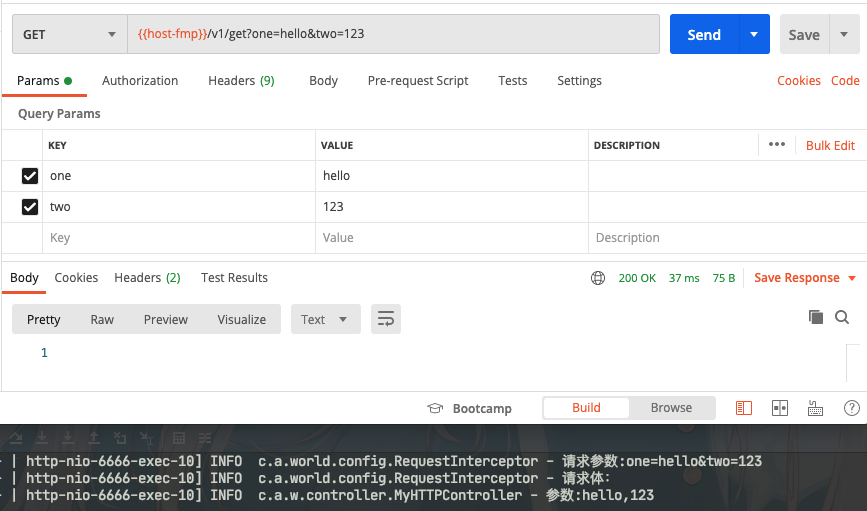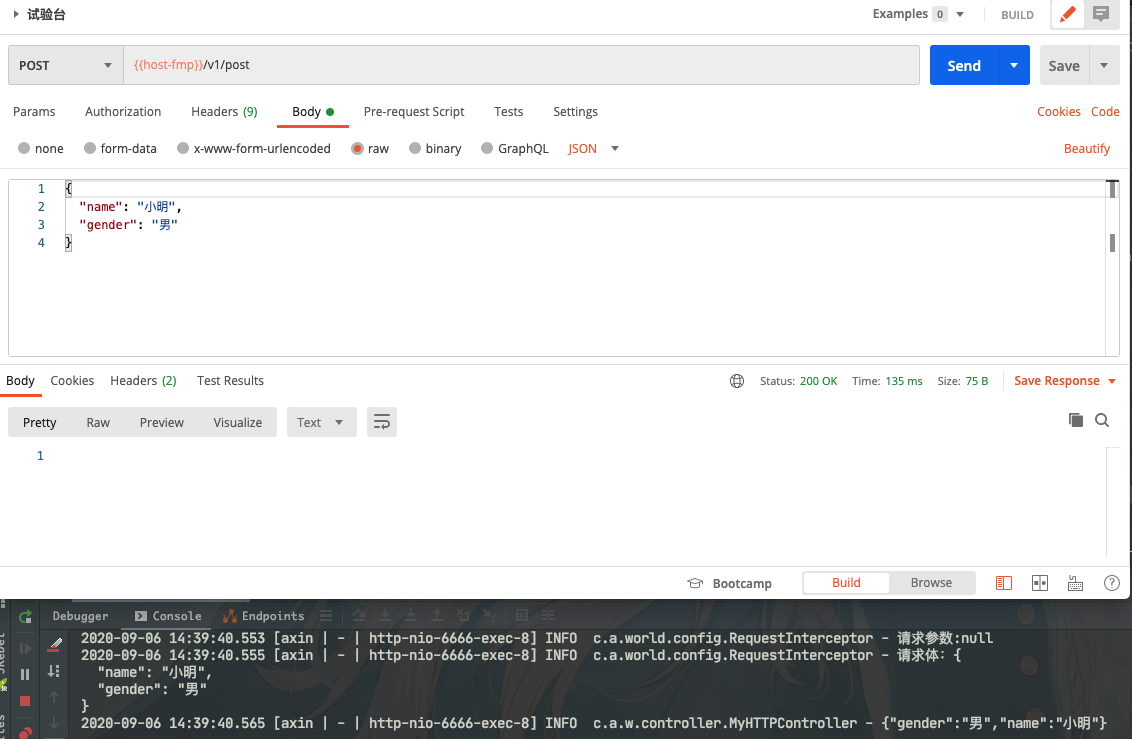SpringBoot攔截器如何獲取http請求參數(shù)
1.1、獲取http請求參數(shù)是一種剛需
我想有的小伙伴肯定有過獲取http請求的需要,比如想
前置獲取參數(shù),統(tǒng)計(jì)請求數(shù)據(jù) 做服務(wù)的接口簽名校驗(yàn) 敏感接口監(jiān)控日志 敏感接口防重復(fù)提交等等各式各樣的場景,這時(shí)你就需要獲取 HTTP 請求的參數(shù)或者請求body,一般思路有兩種,一種就是自定義個(gè)AOP去攔截目標(biāo)方法,第二種就是使用攔截器。整體比較來說,使用攔截器更靈活些,因?yàn)槊總€(gè)接口的請求參數(shù)定義不同,使用AOP很難細(xì)粒度的獲取到變量參數(shù),本文主線是采用攔截器來獲取HTTP請求。
1.2、定義攔截器獲取請求
基于 spring-boot-starter-parent 2.1.9.RELEASE
看起來這個(gè)很簡單,這里就直接上code,定義個(gè)攔截器
/** * @author axin * @summary HTTP請求攔截器 */@Slf4jpublic class RequestInterceptor implements HandlerInterceptor { @Override public boolean preHandle(HttpServletRequest request, HttpServletResponse response, Object handler) throws Exception { //獲取請求參數(shù) String queryString = request.getQueryString(); log.info('請求參數(shù):{}', queryString); //獲取請求body byte[] bodyBytes = StreamUtils.copyToByteArray(request.getInputStream()); String body = new String(bodyBytes, request.getCharacterEncoding()); log.info('請求體:{}', body); return true; }}
然后把這個(gè)攔截器配置一下中:
/** * WebMVC配置,你可以集中在這里配置攔截器、過濾器、靜態(tài)資源緩存等 */@Configurationpublic class WebMvcConfig implements WebMvcConfigurer { @Override public void addInterceptors(InterceptorRegistry registry) { registry.addInterceptor(new RequestInterceptor()).addPathPatterns('/**'); }}
定義個(gè)接口測試一下
/** * @author axin * @summary 提交測試接口 */@Slf4j@RestControllerpublic class MyHTTPController { @GetMapping('/v1/get') public void get(@RequestParam('one') String one, @RequestParam('two') BigDecimal number) { log.info('參數(shù):{},{}', one, number); } @PostMapping('/v1/post') public void check(@RequestBody User user) { log.info('{}', JSON.toJSONString(user)); }}
GET請求獲取請求參數(shù)示例:

POST請求獲取請求Body示例:

我們發(fā)現(xiàn)攔截器在獲取HTTP請求的body時(shí)出現(xiàn)了 400 (Required request body is missing: public void com.axin.world.controller.MyHTTPController.check(com.axin.world.domain.User));同時(shí)也發(fā)現(xiàn)攔截器竟然走了兩遍,這又是咋回事呢?

1.3、為什么攔截器會(huì)重復(fù)調(diào)兩遍呢?
其實(shí)是因?yàn)?tomcat截取到異常后就轉(zhuǎn)發(fā)到/error頁面,就在這個(gè)轉(zhuǎn)發(fā)的過程中導(dǎo)致了springmvc重新開始DispatcherServlet的整個(gè)流程,所以攔截器執(zhí)行了兩次,我們可以看下第二次調(diào)用時(shí)的url路徑:

1.4、ServletInputStream(CoyoteInputStream) 輸入流無法重復(fù)調(diào)用
而之前出現(xiàn)的 Required request body is missing 錯(cuò)誤 其實(shí)是ServletInputStream被讀取后無法第二次再讀取了,所以我們要把讀取過的內(nèi)容存下來,然后需要的時(shí)候?qū)ν馓峁┛杀恢貜?fù)讀取的ByteArrayInputStream。
對于MVC的過濾器來說,我們就需要重寫 ServletInputStream 的 getInputStream()方法。
1.5、自定義 HttpServletRequestWrapper
為了 重寫 ServletInputStream 的 getInputStream()方法,我們需要自定義一個(gè) HttpServletRequestWrapper :
/*** @author Axin* @summary 自定義 HttpServletRequestWrapper 來包裝輸入流*/public class AxinHttpServletRequestWrapper extends HttpServletRequestWrapper { /** * 緩存下來的HTTP body */ private byte[] body; public AxinHttpServletRequestWrapper(HttpServletRequest request) throws IOException { super(request); body = StreamUtils.copyToByteArray(request.getInputStream()); } /** * 重新包裝輸入流 * @return * @throws IOException */ @Override public ServletInputStream getInputStream() throws IOException { InputStream bodyStream = new ByteArrayInputStream(body); return new ServletInputStream() { @Override public int read() throws IOException {return bodyStream.read(); } /** * 下面的方法一般情況下不會(huì)被使用,如果你引入了一些需要使用ServletInputStream的外部組件,可以重點(diǎn)關(guān)注一下。 * @return */ @Override public boolean isFinished() {return false; } @Override public boolean isReady() {return true; } @Override public void setReadListener(ReadListener readListener) { } }; } @Override public BufferedReader getReader() throws IOException { InputStream bodyStream = new ByteArrayInputStream(body); return new BufferedReader(new InputStreamReader(getInputStream())); }}
然后定義一個(gè) DispatcherServlet子類來分派 上面自定義的 AxinHttpServletRequestWrapper :
/*** @author Axin* @summary 自定義 DispatcherServlet 來分派 AxinHttpServletRequestWrapper*/public class AxinDispatcherServlet extends DispatcherServlet { /** * 包裝成我們自定義的request * @param request * @param response * @throws Exception */ @Override protected void doDispatch(HttpServletRequest request, HttpServletResponse response) throws Exception { super.doDispatch(new AxinHttpServletRequestWrapper(request), response); }}
然后配置一下:
/** * WebMVC配置,你可以集中在這里配置攔截器、過濾器、靜態(tài)資源緩存等 */@Configurationpublic class WebMvcConfig implements WebMvcConfigurer { @Override public void addInterceptors(InterceptorRegistry registry) { registry.addInterceptor(new RequestInterceptor()).addPathPatterns('/**'); } @Bean @Qualifier(DispatcherServletAutoConfiguration.DEFAULT_DISPATCHER_SERVLET_BEAN_NAME) public DispatcherServlet dispatcherServlet() { return new AxinDispatcherServlet(); }}
再調(diào)用一下 POST請求:

請求成功!
1.5、總結(jié)一下 展望一下
如果你想對HTTP請求做些騷操作,那么前置獲取HTTP請求參數(shù)是前提,為此文本給出了使用MVC攔截器獲取參數(shù)的樣例。
在獲取HTTP Body 的時(shí)候,出現(xiàn)了 Required request body is missing 的錯(cuò)誤,同時(shí)攔截器還出現(xiàn)執(zhí)行了兩遍的問題,這是因?yàn)?ServletInputStream被讀取了兩遍導(dǎo)致的,tomcat截取到異常后就轉(zhuǎn)發(fā)到 /error 頁面 被攔截器攔截到了,攔截器也就執(zhí)行了兩遍。
為此我們通過自定義 HttpServletRequestWrapper 來包裝一個(gè)可被重讀讀取的輸入流,來達(dá)到期望的攔截效果。
在獲取到HTTP的請求參數(shù)后,我們可以前置做很多操作,比如常用的服務(wù)端接口簽名驗(yàn)證,敏感接口防重復(fù)請求等等。
個(gè)人水平有限,如果文章有邏輯錯(cuò)誤或表述問題還請指出,歡迎一起交流。
到此這篇關(guān)于SpringBoot攔截器如何獲取http請求參數(shù)的文章就介紹到這了,更多相關(guān)SpringBoot攔截器獲取http請求參數(shù)內(nèi)容請搜索好吧啦網(wǎng)以前的文章或繼續(xù)瀏覽下面的相關(guān)文章希望大家以后多多支持好吧啦網(wǎng)!
相關(guān)文章:
1. JavaWeb Servlet中url-pattern的使用2. ASP中格式化時(shí)間短日期補(bǔ)0變兩位長日期的方法3. asp知識整理筆記4(問答模式)4. 怎樣才能用js生成xmldom對象,并且在firefox中也實(shí)現(xiàn)xml數(shù)據(jù)島?5. javascript xml xsl取值及數(shù)據(jù)修改第1/2頁6. ASP實(shí)現(xiàn)加法驗(yàn)證碼7. XML解析錯(cuò)誤:未組織好 的解決辦法8. 小技巧處理div內(nèi)容溢出9. js的一些潛在規(guī)則使用分析10. ASP刪除img標(biāo)簽的style屬性只保留src的正則函數(shù)

 網(wǎng)公網(wǎng)安備
網(wǎng)公網(wǎng)安備